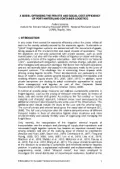-
Past ETC Papers

Browse, search and view papers from the past AET Conferences.
-
Members' Area

AET promotes networking and exchange of ideas, information and opportunities amongst members.
Conference Papers 2011
Glasgow, United Kingdom
ETC Conference Papers 2011
A model of optimizing the private and social cost-efficiency of port-hinterland container logistics
Seminar
Day 2 (11 Oct 2011), Freight & Logistics, Ports and Airports, 19:00 - 22:00
Status
Accepted, documents submitted
Authors
F Iannone, Institute for Service Industry Research (IRAT) - National Research Council (CNR), IT
Short abstract
The paper presents the results deriving from the implementation of an optimization model for the economic analysis and strategic planning of sustainable port-hinterland container logistics systems.
Abstract
The transportation and logistics planning, policy and research communities are moving towards the paradigm of sustainability, which implies a broader perspective to address problems and find solutions. Sustainable or 'green' logistics systems are concerned with the movement of people and goods, taking account of environmental and social factors.
To date, there have been very few studies incorporating the external costs of transportation into the economic analysis and strategic planning of intermodal freight logistics systems. This paper intends to contribute to the literature by analyzing sustainable port-hinterland container distribution issues. In particular, it has been employed a capacitated multimodal and multicommodity network programming model, called 'interport model', to investigate the inland distribution of containers handled at the seaports of Naples and Salerno located in the Campania region of Southern Italy. The loading units can transit through the regional dry port facilities located at Nola and Marcianise (the so called 'interports'), as well as through extra-regional locations which have a railway terminal, before reaching their destination.
The model optimizes simultaneously the flows of containers imported and to be exported through the regional logistic system. It minimizes all the container-related generalized logistic costs throughout the entire port-hinterland multimodal network, while allowing to highlight and measure the benefits arising both from shifting the seaport exit/entry of containers to the regional interports ('extended gateways'), and from employing intermodal solutions for inland distribution. The internal logistic costs include transportation costs (by road and railway), terminal handling and storage costs, customs control costs, in-transit inventory holding costs, and container leasing costs. In addition, the objective function of the model also internalizes the external costs in terms of greenhouse gases emissions, air pollution, noise, accidents and congestion due to the different inland transport modes taken into consideration (road and rail).
The results in terms of logistic flows, internal costs and external costs deriving from the application of the model have been compared both with the observed real situation and with the results deriving from the solution of a second model featuring the same structure and data, but whose objective function does not internalize the transport external diseconomies. The different scenarios have been also compared in terms of physical air emissions due to the transport operations.
By this way, it has been possible to make a really detailed assessment of the potential to improve the current performances of the Campanian seaport-interport logistic system for inland container distribution. The attained results can constitute a useful knowledge base for policy initiatives aimed to stimulate sustainable port-hinterland container logistics solutions which are innovative and effective in terms of modal rebalance and pursuit of social welfare.
The paper is organized as follows. Section 1 provides an overview on introductory issues concerning inland logistics and sustainability. Section 2 presents a brief review of some contributions of the port-hinterland container logistics systems analysis literature, while also highlighting antecedents and original features of the interport model. Section 3 contains both a methodological description and a stylized formulation of the model. Section 4 presents the main features and results of the empirical applications of the model; the results obtained in the different modeling scenarios are also compared with the observed real situation. Section 5 addresses conclusions
Documents:

Association For
European Transport
Forester House
Doctors Lane
Henley-in-Arden
Warwickshire, UK
B95 5AW
+44 (0) 15 64 793552
VAT number: 710 1866 64
Conference Supporters & Endorsers




Legal Entity
The Association for European Transport is registered as an Association ('vereniging') with the Chamber of Commerce for Haaglanden in The Netherlands under company number 27170096.
Built on Zenario




